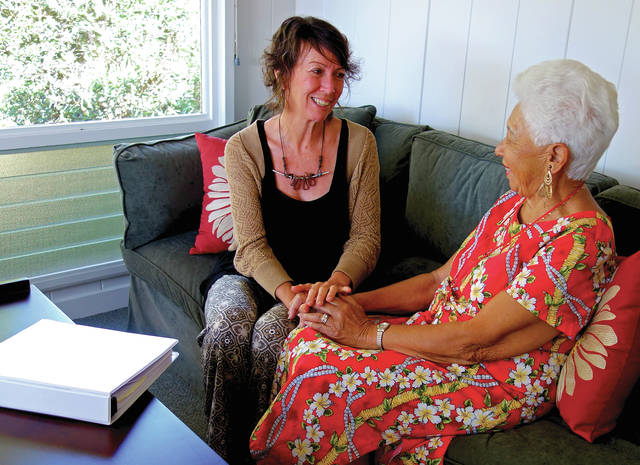WAIMEA — Since 1986, North Hawaii Hospice has been providing end-of-life care and support for their local community members. The in-home care by their trained staff and volunteers has eased the journey out of life and given support to family and friends left behind.
Recently, through the efforts of Bobbi Bryant, the hospice’s volunteer coordinator, training has been offered to volunteers to become end-of-life doulas, returning to old wisdom and benefits that can be derived from it.
“Caring for the sick and dying before the Civil War happened in the home. It was just a continuation of women raising children. They cared for the elders at the end of their life,” Bryant said.
But with the rise of medical technology, the end-of-life stage was taken out of the hands of the family, and the knowledge and wisdom was lost.
“People were being brought to the hospital to die, and then they were embalmed so we weren’t really caring for people at the end of life. We lost our skills,” Bryant said.
The resurgence of end-of-life doulas are a reflection of the return of birth doulas beginning in the 1970s.
“Midwives to the dying have been around for a long time. It started as a result of the resurgence of birth doulas and midwives. The model transferred to how we can care for people at the end. There was a lack of education around the dying process and when people wanted to start caring for their loved ones, there was a lot fear. The conversation around death had come to a standstill,” Bryant reflected.
Recognizing the need for doula training, Bryant attended a conference on death and dying on Maui last April.
“When I came back, I spent the next several months creating a curriculum and trained 14 people including nurses, an ER doc and health aids,” she said.
The decision to enter hospice care can be difficult, but once made it can free the family and caregiver to focus on the patient.
“If you come for hospice support early, you can have so much support. There’s so much pain and suffering that isn’t necessary,” Bryant shared.
The North Hawaii Hospice team includes a lead, general and vigil doula. Initially, the lead doula meets with the family and the patient to provide information about all the ways they can assist them, and establishes a relationship of trust.
The doula’s role is to provide non-medical comfort and to be a facilitator; both subtle and profound. On a practical level, the doula does whatever needs to be done — offering companionship, running errands, assisting with household chores, providing healthful meals and helping with bathing and personal care.
“You just be there, be grounded and love them. You need a way to get trust from people. As soon as I get there, I get my hands on them. The medicine doesn’t always help. So when they’re in a lot of pain I’m running energy with that pain and helping them to move the pain through, and helping them to relax,” said Rose Riedesel, a hospice volunteer and healing body worker.
But a primary role for the doula is to sit, listen and be aware of what’s happening with the various aspects of the patient’s care in order to act as an information conduit between the medical care team and the patient.
“The doula is an adjunct to the professional people involved. They’ll find out some information that the care team needs to know and they’ll pass that on, or if the family needs some information the doula will pass that on to them,” Bryant said.
Emotional well-being is vital to ease the dying process. A big part of the doula’s role is to encourage the patient to “talk with people about their life and find places of deep meaning; a deep connection in life, the people who meant something to them in their life, the experiences, what their passions were and what their difficulties were. It allows the person to sink into this process of dying,” Bryant observed.
Another role for the doula is to notice any unresolved issues, which can cause anxiety and tension in the patient.
“They listen in the stories for anything that’s unresolved. Sometimes you’ll hear something about a family member who needs to be forgiven. We want that person to have as much relaxation as possible in the end,” Bryant said.
The lead doula also helps the patient and family with a vigil plan that includes the creation of a peaceful space, along with a team of doulas sitting in shifts when the active dying phase begins.
“They help create a beautiful space for the dying person to be in with things such as art, quilts, photos and a certain scent. They ask, ‘Would you like something read to you? Who do you want with you? Can somebody get into bed with you?’” Bryant said.
After the patient has passed, the doula assists the family in making arrangements, and follows up with them.
“The doula assesses how to help the family at that time and backs out. In a couple of days, they give the family a call and ask to come and talk about what happened, maybe a beautiful touch or an interaction before the person actually stopped speaking,” Bryant said.
Just as with the birth process, dying is a time of loving connection.
“Without that relationship to that final process, what your loved one is going through and caring for the body, the grieving process can be very difficult. Somebody’s being labored out of life. That person needs to be loved and cared for every step of the way,” Bryant concluded.
If interested in participating in future doula training at North Hawaii Hospice: Call Bobbi Bryant at 930-6625






